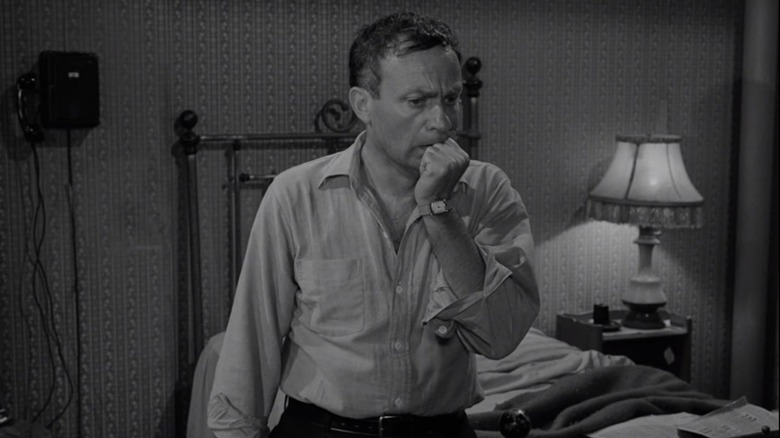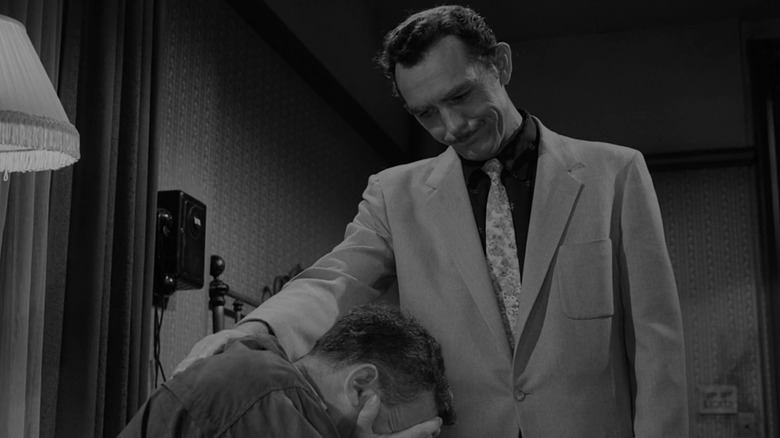A Genius Trick Let A Twilight Zone Actor Co-Star With His Own Reflection
Along with being one of the finest shows in the history of television, the original run of Rod Serling's "The Twilight Zone" could function as a laboratory for advancements in visual effects. The often fantastical nature of the series, and Serling's desire to push the envelope of the still-developing medium's potential, was something of a creative sandbox for directors. As such, the show attracted not just aspiring young filmmakers like Richard Donner, Jack Smight, and Richard C. Sarafian, but established masters on the level of Jacques Tourneur, Don Siegel, and Norman Z. McLeod.
Douglas Heyes was more of a journeyman director when entered "The Twilight Zone." His experience and skill were highly valuable to Serling, who assigned him a total of nine episodes – the second most over the show's five seasons next to John Brahm's 12. Heyes' most celebrated episode is probably "Eye of the Beholder," the creepy tale of a woman who's undergone extensive plastic surgery to make her look "normal."
Less well known is perhaps "Nervous Man in a Four Dollar Room," a one-man show of sorts starring Joe Mantell (the great character actor who uttered "Forget it, Jake. It's Chinatown") as a two-bit gangster ordered by his boss to carry out his very first murder. This doesn't sound like the kind of scenario that would inspire technical invention, but its central conceit really did require a good bit of problem-solving.
He's talking to the man in the mirror
"Nervous Man in a Four Dollar Room" opens with Mantell anxiously awaiting the arrival of his handler. When the man (William D. Gordon) finally arrives, he verbally and physically badgers the insecure sap, who can't countenance taking the life of another human being (in this case, a barkeep who refuses to cough up protection money).
When the mobster leaves, Mantell is confronted with a mirror version of himself. The iteration of the character is his polar opposite: he's sharp, confident, and wholly unwilling to do the bidding of the boss. The two versions of Mantell enter into a dialogue, with the latter descending into self-pity as he laments the awful choices he's made out of sheer weakness. As he tries to talk himself into carrying out the deed, the mirror incarnation demands that he be allowed to take over, thus saving both of them from total spiritual ruin.
How did Heyes pull this off visually years before CGI and other digital cinema trickery?
The two Mantells
As explained in Marc Scott Zicree's indispensable "The Twilight Zone Companion," the typical approach would've employed a split-screen effect. Heyes was against this. He worried that this technique would've constrained Mantell's movement, resulting in a stiff, unconvincing performance.
Heyes' solution was to go with rear projection. This meant Mantell had to shoot his alter ego portrayal first, which would then be projected onto the mirrors as he played the wimpy version of his character. It worked brilliantly. According to Heyes:
"Joe played all the scenes in this room just as if he was playing with another actor. He could walk up to the guy, walk away from him, cross him, he could do everything. And he could maintain eye contact with him, also, because he was looking right at himself in his 'mirror."
For a single-set episode, "Nervous Man in a Four Dollar Room" is surprisingly dynamic. Perhaps even more surprising (and I'm going to spoil the episode here) is that the drama ends on an upbeat note. The mirror man takes control of the situation, and, when the gangster comes back, roughs him up and sends him packing. Our protagonist is literally a new man, and he's determined to fix his mess of a life. He is now, as Serling notes in the epilogue, "on his way to join the company of men." It's just another classic half-hour of television on a series riddled with them.


